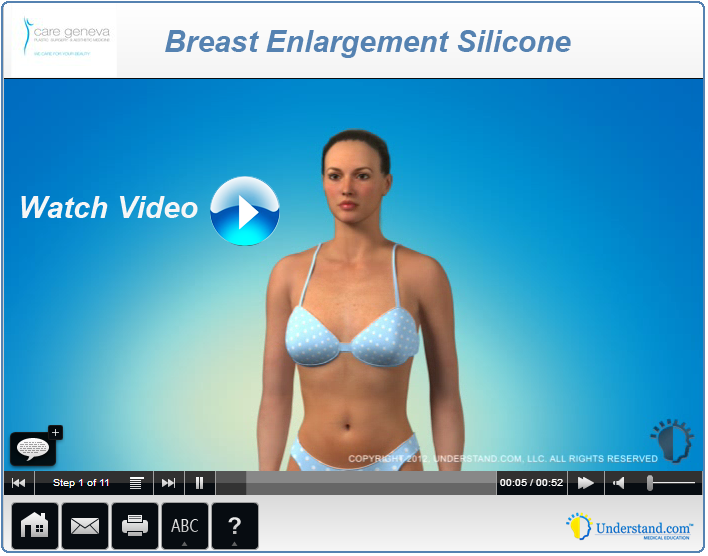Breast Augmentation- Breast Enlargement – Care Geneva
Small Breast is defined as an insufficient breast size in relation to the patient’s body type. It may be a primarily condition (small breasts since puberty) or come about secondarily, following significant weight loss or pregnancy.
There may also be some sagging, perhaps due to the gland sagging and the skin stretching.
Breast enlargement involves correcting the breast size considered to be insufficient by inserting implants (prosthesis).
Animation
Our educational videos of procedure contain information media and notes –
Click on the image below to watch!
Learn more about breast enlargement
Depending on the shape of the breast, there are variations in the technique and in the scars that will be located either in the submammary fold or around the areola. The implants are positioned either behind or in front of the large pectoral muscle, or even under the pectoral muscle fascia (new technique).
We prefer outpatient surgery. The surgery may be performed with local anaesthesia and sedation, and it lasts approximately 1 hour 30 minutes. In some cases or upon request, general anaesthesia may be offered with a one-night hospital stay.
Breast enlargement Post-operative recovery
We will prescribe you analgesic treatment to control post-operative pain. Swelling and bruising are common early on, as well as discomfort when raising the arms. Lymph drainage may sometimes be offered to accelerate the reduction of swelling and the softening of scars.
After 24 hours, the first bandage is removed and replaced by a bra to be worn day and night for 4 to 6 weeks.
The stitches are absorbable and will not need to be removed.
It is reasonable to expect to stop working for 8 to 10 days for convalescence.
We recommend waiting one to two months before resuming sports activities.
We also recommend regular monitoring for one year, then an annual check up thereafter.
Possible complications:
- Haematomas, which rarely require additional surgery.
- Infections, which may be treated by antibiotics. In rare cases, it may be necessary to operate again.
- Changes around the prosthesis. At any time, the surrounding that forms around the prosthesis may thicken, harden, and deform the prosthesis. To avoid this problem, we ask all of our patients to massage their scars in the shower for the first few months after the surgery.
- Pain. Inserting prostheses, especially under the pectoral muscle, may be painful for the first few days. To improve comfort, the patient must carefully follow the prescribed anti-pain treatment.
Please also follow the link of the Swiss Society of Plastic Surgery for more information
FAQ for breast augmentation
What is capsular contracture?
This is a scar that forms around the implant, causing it to feel firm, look unnatural, and potentially hurt. When you see pictures of a woman with obvious implants who looks like she has “coconut breasts”, she more than likely has a severe capsular contracture. If you develop a mild capsular contracture, you may not be bothered by it and may not even notice you have one. If you develop one which is moderate or severe, you will probably require surgery to correct the problem. Surgery involves removing the scar and placing a new implant. In spite of this, the capsular contracture may return. Placing the implant under the muscle has a lower risk of capsular contracture than placing the implant over the muscle.
Is there an interference with mammography?
Breast implants interfere with the ability of a mammogram to “see” all of your breast tissue. Placing the implant under the muscle least interferes. With the breast implant under your muscle, mammograms can “see” about 90% of your breast tissue. With the breast implant over the muscle, mammograms can “see” 75% of your breast tissue. Either way, implants do not interfere with self breast examination, which is how the majority of breast cancers are discovered. They also do not interfere with ultrasound or MRI scans, which are helpful in evaluation of breast masses.
What is an implant displacement?
Implants can move out of position at anytime after surgery. They can move upward, downward, left or right. If they move only a little, you may not even notice. If they move a lot, you may need further surgery to move them back into position. Fortunately,
this problem is not common. One exception is in women who have very large implants. The larger the implant, the greater the chance that it will displace downward.
Is breast feeding and pregnancy problematic after breast enlargement?
Breast feeding ability is not altered by implants. Many women ask about the effect of future pregnancy on augmented breasts. In most cases, implants will not affect the fate of your postpartum breasts. Here is why: following pregnancy (and breast feeding), your breasts will shrink to their pre-pregnancy size (or there about). During this process of shrinking, your breast skin may either tighten or not tighten. If it tightens, you will most likely not have breast droop. If it does not tighten, then your breasts will unfortunately droop. Whether or not the skin tightens has little or nothing to do with the presence or absence of implants.
Will I need a further surgery after a breast enlargement?
Women unwilling to accept the potential need for further surgery should not have breast augmentation. Understand that if you receive any implant in your body – whether it be a pace maker, artificial joint, artificial heart valve, or anything – that one of the inherent risks is that you may need further surgery on it at some point in your life.
























